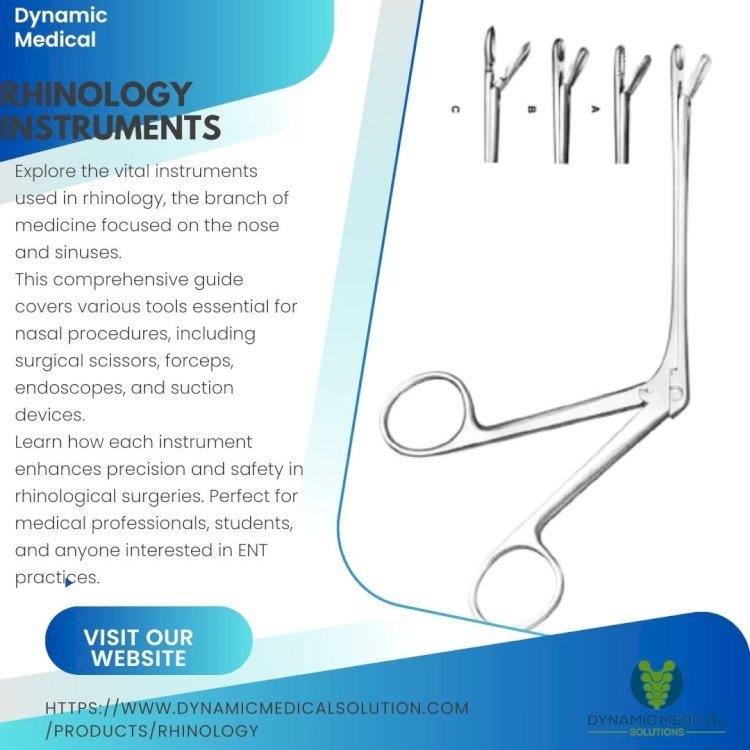The Types of Rhinology Instruments: Essential Tools for Nasal and Sinus Care

The Types of Rhinology Instruments: Essential Tools for Nasal and Sinus Care
Rhinology istruments, the branch of medicine that focuses on the nose and sinuses, requires a wide range of specialized tools to diagnose, treat, and manage various nasal and sinus conditions. From diagnostic procedures to complex surgeries, the success of rhinologists heavily depends on the precision and functionality of rhinology instruments. These instruments are specifically designed to handle the delicate structures within the nasal cavity and sinuses, ensuring patient safety and surgical accuracy.
In this article, we will explore the different types of rhinology tools and their key roles in both routine examinations and advanced surgical procedures.
1. Nasal Speculums
One of the most fundamental rhinology instruments, the nasal speculum is used to widen the nostrils, allowing the doctor to visually inspect the nasal cavity. Nasal speculums come in various sizes, depending on the patient's anatomy and the type of examination. This tool is essential in routine examinations, as it provides a clearer view of the nasal passages, helping detect issues such as inflammation, blockages, or structural abnormalities.
- Use: Diagnostic tool to examine the nasal cavity.
- Common Procedures: Routine check-ups, nasal cavity inspections.
2. Endoscopes
Endoscopes are among the most versatile and commonly used rhinology tools. These instruments consist of a thin, flexible tube with a light and a camera that allow the doctor to view the inside of the nasal passages and sinuses on a monitor. Endoscopes come in different angles (0°, 30°, and 70°), enabling the visualization of hard-to-reach areas.
- Use: Diagnostic and surgical tool for viewing inside the nasal passages and sinuses.
- Common Procedures: Functional Endoscopic Sinus Surgery (FESS), nasal endoscopy for sinusitis, detecting tumors, or foreign bodies.
3. Blakesley Forceps
Blakesley forceps are precision instruments used to grasp and remove tissue, such as nasal polyps or other obstructions, during nasal and sinus surgery. These forceps come in various shapes (straight, angled, upturned, and downturned) to provide flexibility during different procedures.
- Use: Surgical tool for removing tissue from the nasal cavity and sinuses.
- Common Procedures: Polypectomy, FESS, removal of nasal obstructions.
4. Microdebriders
Microdebriders are powered rhinology instruments that allow surgeons to precisely remove soft tissue while minimizing damage to surrounding areas. This tool consists of a rotating blade that shaves tissue and suctions it away, making it particularly useful in surgeries where precision is critical.
- Use: Surgical tool for removing polyps or diseased tissue with precision.
- Common Procedures: Polypectomy, FESS, removal of nasal obstructions and blockages.
5. Frontal Sinus Curettes
Curettes are small, spoon-shaped instruments used to scrape and remove tissue from the frontal sinuses. These rhinology tools come in different sizes and shapes, allowing surgeons to access and treat specific areas within the sinuses.
- Use: Surgical tool for scraping and removing tissue from sinuses.
- Common Procedures: Frontal sinus surgery, removal of diseased or infected tissue.
6. Suction Devices
Suction devices are vital in both diagnostic and surgical procedures in rhinology. These instruments are used to remove excess mucus, blood, and other fluids from the nasal cavity and sinuses, helping to maintain a clear view of the operative field.
- Use: Removes fluids and keeps the surgical field clear.
- Common Procedures: FESS, nasal endoscopy, post-surgical care.
7. Balloon Sinuplasty Devices
Balloon sinuplasty is a relatively new, minimally invasive procedure that involves the use of balloon dilation catheters. These instruments are used to treat chronic sinusitis by dilating the sinus openings, allowing better drainage without the need for invasive surgery. The balloon catheter is inserted into the sinus and gently inflated, which widens the sinus passageway.
- Use: Minimally invasive tool for sinus dilation.
- Common Procedures: Balloon sinuplasty for treating chronic sinusitis.
8. Septum Elevators
Septum elevators are used in procedures that involve the nasal septum, such as septoplasty. These instruments help lift and separate tissue from the septum, allowing surgeons to reposition or reshape the nasal septum to improve airflow.
- Use: Surgical tool for lifting and repositioning nasal tissue.
- Common Procedures: Septoplasty, rhinoplasty, nasal reconstruction.
9. Osteotomes
Osteotomes are sharp surgical instruments used to cut or reshape bones during procedures like rhinoplasty or septoplasty. These rhinology tools allow surgeons to precisely modify the bone structure of the nose to correct deformities or improve nasal function.
- Use: Surgical tool for reshaping nasal bones.
- Common Procedures: Rhinoplasty, septoplasty, nasal fracture repair.
10. Freer Elevators
Freer elevators are double-ended instruments, one side blunt and the other sharp, designed to lift and separate tissues during surgery. These tools are particularly useful in nasal surgeries where cartilage or bone needs to be accessed without damaging surrounding tissues.
- Use: Surgical tool for lifting and separating nasal tissues.
- Common Procedures: Septoplasty, rhinoplasty, sinus surgeries.
11. Rhinoscopes
Rhinoscopes are a type of endoscope specifically designed for examining the nasal passages. They allow for detailed examination of the nasal cavity and are often used in both diagnostic and therapeutic procedures. Like other endoscopes, they are equipped with cameras and lights for clear visualization.
- Use: Diagnostic tool for detailed examination of the nasal cavity.
- Common Procedures: Nasal endoscopy, diagnosing blockages or structural abnormalities.
Conclusion
The wide range of rhinology instruments available today demonstrates the complexity and precision required in nasal and sinus care. Each of these specialized rhinology tools plays a vital role in helping rhinologists accurately diagnose and treat a variety of nasal and sinus conditions. From simple diagnostic tools like nasal speculums to advanced surgical instruments like microdebriders and balloon sinuplasty devices, these instruments have revolutionized the field of rhinology by enabling more effective, minimally invasive procedures with better patient outcomes.
As technology continues to advance, we can expect even more refined and innovative rhinology instruments to emerge, further improving patient care and expanding the capabilities of nasal and sinus treatment.For more info visit our website Dynamic Medical
What's Your Reaction?















